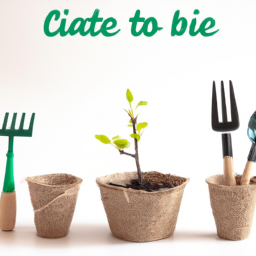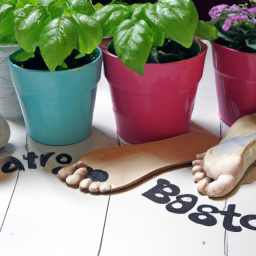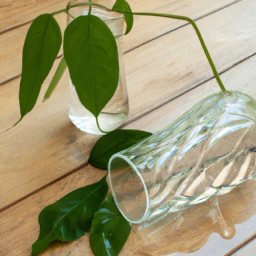
Are you looking for ways to reduce the amount of plastic in your indoor plant collection? In this blog post, we will explore eco-friendly alternatives to traditional plastic pots and planters. By making simple changes to the way you care for your plants, you can help reduce your environmental impact and create a more sustainable home. Let’s dive into some creative and environmentally-friendly solutions for reducing indoor plant plastic.
Sustainable Alternatives to Plastic Plant Pots
Biodegradable Plant Pots
When looking for eco-friendly alternatives to plastic plant pots, biodegradable options are a great choice. These pots are made from materials such as peat, wood pulp, or coconut coir, which break down naturally over time. Biodegradable plant pots are not only better for the environment, but they also provide nutrients to the plants as they decompose. These pots are available in various sizes and shapes, making them a versatile option for indoor gardening.
One popular biodegradable plant pot option is the peat pot, which is made from compressed peat moss. Peat pots are great for seed starting, as they can be planted directly into the ground without disturbing the roots of the plant. Another eco-friendly choice is the wood pulp pot, which is made from recycled paper products. These pots are sturdy and durable, making them a long-lasting option for indoor plants.
Coconut coir pots are another sustainable alternative to plastic plant pots. These pots are made from the fibrous husk of coconuts and are biodegradable and renewable. Coconut coir pots are lightweight and breathable, allowing for proper air circulation around the roots of the plant. These pots are also resistant to mold and mildew, making them a great choice for indoor plants.
In addition to being environmentally friendly, biodegradable plant pots are also aesthetically pleasing. They come in a variety of natural colors and textures, adding a touch of organic beauty to your indoor garden. By choosing biodegradable plant pots, you can reduce your carbon footprint and help protect the planet for future generations.
Terra Cotta Plant Pots
Terra cotta plant pots are a classic and sustainable alternative to plastic plant pots. These pots are made from clay that is fired at high temperatures, making them durable and long-lasting. Terra cotta pots are breathable, allowing for proper air circulation around the roots of the plant. This helps prevent root rot and promotes healthy growth.
One of the benefits of terra cotta plant pots is their ability to absorb excess moisture from the soil, helping to prevent overwatering. This can be especially beneficial for indoor plants that are prone to root rot. Terra cotta pots also provide insulation to the roots, helping to regulate the temperature of the soil and protect the plant from extreme temperature fluctuations.
In addition to their functionality, terra cotta plant pots are also aesthetically pleasing. These pots have a natural earthy look that complements a variety of plant styles and home decor. Terra cotta pots are available in a range of sizes and shapes, making them a versatile option for indoor gardening. By choosing terra cotta plant pots, you can reduce your use of plastic and create a more sustainable indoor garden.
Recycled Plant Pots
Another eco-friendly alternative to plastic plant pots is recycled plant pots. These pots are made from materials such as recycled plastic, glass, or metal, reducing the amount of waste that ends up in landfills. Recycled plant pots come in a variety of styles and sizes, making them a versatile option for indoor gardening.
Recycled plastic plant pots are a popular choice for indoor plants, as they are durable and long-lasting. These pots are made from post-consumer plastic waste, such as water bottles and food containers, giving them a second life as a plant pot. Recycled plastic plant pots are lightweight and easy to clean, making them a convenient option for indoor gardening.
Glass and metal plant pots are another sustainable choice for indoor plants. These pots are made from recycled materials, such as old jars or cans, that have been repurposed into plant containers. Glass and metal plant pots are sturdy and resistant to breakage, making them a durable option for indoor gardening. By choosing recycled plant pots, you can help reduce your environmental impact and create a more sustainable indoor garden.
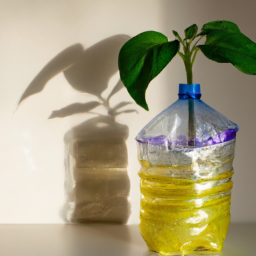
Eco-Friendly Plant Containers for Indoor Gardening
As an expert in reducing indoor plant plastic, I understand the importance of finding eco-friendly alternatives for plant containers. Plastic pots and containers can contribute to environmental pollution and harm our planet. In this guide, I will provide you with some sustainable options for indoor gardening that are both stylish and eco-friendly.
Biodegradable Pots
One of the best alternatives to plastic plant containers is biodegradable pots. These pots are made from natural materials such as coconut coir, rice husks, or peat moss, which break down easily in the environment. Biodegradable pots are not only eco-friendly but also provide nutrients to the plants as they decompose.
These pots come in various shapes and sizes, making them suitable for different types of indoor plants. They are also breathable, allowing air to reach the plant’s roots and promote healthy growth. Biodegradable pots can be easily disposed of in compost bins or outdoor gardens, reducing waste and helping the environment.
When choosing biodegradable pots, look for ones that are certified organic and free from harmful chemicals. These pots are a sustainable choice for indoor gardening and can help you reduce your plastic use while caring for your plants.
Terracotta Pots
Another eco-friendly option for indoor plant containers is terracotta pots. These pots are made from natural clay and are durable, breathable, and visually appealing. Terracotta pots have been used for centuries for gardening due to their ability to regulate moisture and temperature, making them ideal for indoor plants.
Terracotta pots are reusable and can last for many years with proper care. They are also biodegradable, so when they eventually break or become unusable, they can be safely disposed of in the environment. Terracotta pots come in various sizes and styles, allowing you to choose the perfect container for your indoor garden.
When using terracotta pots, make sure to water your plants carefully as the porous material can absorb moisture quickly. Avoid overwatering to prevent root rot and keep your plants healthy and thriving in their eco-friendly containers.
Bamboo Planters
If you’re looking for a stylish and sustainable option for indoor plant containers, consider bamboo planters. Bamboo is a fast-growing and renewable resource that is both biodegradable and durable. Bamboo planters come in a variety of designs and sizes, adding a touch of natural beauty to your indoor garden.
These planters are lightweight, making them easy to move around and rearrange your plants as needed. Bamboo planters are also resistant to water damage and can withstand indoor conditions, making them a long-lasting choice for your indoor garden. By choosing bamboo planters, you can reduce your plastic use and contribute to a healthier planet.
When using bamboo planters, make sure to place a saucer or liner inside to protect your furniture from water damage. Avoid placing bamboo planters in direct sunlight or areas with high humidity to prevent warping or discoloration. With proper care, bamboo planters can be a sustainable and stylish choice for your indoor gardening needs.

Reducing Indoor Plant Plastic: Eco-Friendly Alternatives
Introduction
As an expert in reducing indoor plant plastic waste, I am here to provide you with eco-friendly alternatives that will not only benefit the environment but also enhance the beauty of your indoor space. Plastic pots and containers are commonly used in indoor plant care, but they can have a negative impact on the environment due to their non-biodegradable nature. By making simple changes to your indoor plant care routine, you can significantly reduce plastic waste and create a more sustainable living environment.
When it comes to reducing plastic waste in indoor plant care, there are several eco-friendly alternatives that you can explore. From using biodegradable pots to upcycling containers, there are plenty of options available to help you minimize your plastic footprint. In this guide, I will provide you with a step-by-step approach to reducing plastic waste in indoor plant care, so you can make a positive impact on the environment while enjoying the benefits of nurturing your indoor plants.
Choosing Biodegradable Pots
One of the most effective ways to reduce plastic waste in indoor plant care is by choosing biodegradable pots. These pots are made from organic materials such as coconut coir, rice husks, or biodegradable plastics, which break down naturally over time. Biodegradable pots not only help reduce plastic waste but also provide a healthier environment for your plants, as they allow for better aeration and moisture retention. When selecting biodegradable pots, look for options that are certified as compostable and free from harmful chemicals.
In addition to using biodegradable pots, you can also consider upcycling containers for your indoor plants. Upcycling involves repurposing items that would otherwise be thrown away, such as tin cans, glass jars, or wooden crates, as plant containers. Not only does upcycling reduce plastic waste, but it also adds a unique touch to your indoor plant display. Before upcycling containers, make sure to clean and sanitize them thoroughly to prevent any potential harm to your plants.
Another eco-friendly alternative to plastic pots is using fabric grow bags for your indoor plants. Fabric grow bags are made from breathable fabric that promotes healthy root growth and prevents waterlogging. These bags are reusable, washable, and biodegradable, making them a sustainable choice for indoor plant care. Fabric grow bags come in various sizes and shapes, allowing you to accommodate different plant species and sizes in your indoor garden. Consider switching to fabric grow bags to reduce plastic waste and enhance the growth of your indoor plants.
In conclusion, reducing plastic waste in indoor plant care is essential for creating a more sustainable living environment. By choosing biodegradable pots, upcycling containers, and using fabric grow bags, you can minimize your plastic footprint and contribute to a healthier planet. Make the switch to eco-friendly alternatives today and enjoy the benefits of nurturing your indoor plants in a more environmentally friendly way.
Key Takeaways of this article
Are you looking to reduce the amount of plastic in your home, but love having indoor plants? You’re not alone! Many plant lovers are searching for eco-friendly alternatives to the plastic pots and containers that are commonly used. Luckily, there are plenty of options available to help you reduce your plastic footprint while still enjoying your favorite greenery.
One great alternative to plastic pots is using terracotta or ceramic pots. These materials are durable, long-lasting, and can add a touch of style to your indoor plant collection. Another option is to repurpose containers you already have at home, such as glass jars or metal tins. Not only does this help reduce waste, but it also adds a unique and personal touch to your plant display. By making simple switches to more sustainable materials, you can enjoy your indoor plants guilt-free and help protect the environment at the same time.
Common Questions and Answers:
Q1: Why should I consider reducing plastic in my indoor plant care?
A1: Reducing plastic in your indoor plant care is important for the environment as plastic waste contributes to pollution and harm to wildlife. By using eco-friendly alternatives, you can help reduce your carbon footprint and support sustainability efforts.
Q2: What are some eco-friendly alternatives to plastic pots for indoor plants?
A2: Some eco-friendly alternatives to plastic pots for indoor plants include terracotta pots, biodegradable pots made from materials like coconut coir or rice husks, ceramic pots, glass containers, and repurposed containers such as mason jars or tin cans.
Q3: How can I reduce plastic waste in my plant watering routine?
A3: To reduce plastic waste in your plant watering routine, consider using a watering can made from metal or glass instead of plastic. You can also collect rainwater for watering your plants or reuse water from cooking or rinsing fruits and vegetables.
Q4: Are there eco-friendly alternatives to plastic plant labels?
A4: Yes, there are eco-friendly alternatives to plastic plant labels such as wooden plant markers, biodegradable paper labels, or even using a permanent marker directly on the pot. You can also get creative and make your own plant labels using materials like recycled cardboard.
Q5: How can I repurpose or recycle plastic pots from my indoor plants?
A5: You can repurpose or recycle plastic pots from your indoor plants by using them for storage, organizing small items, or even as drainage trays for other plants. If you no longer need them, check with your local recycling facilities to see if they accept plastic pots for recycling.
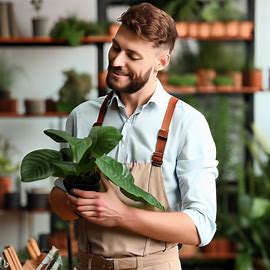
Alex Turner is a sustainable gardening advocate and the founder of an acclaimed indoor gardening blog. With a focus on eco-friendly practices and urban sustainability, Alex combines his background in environmental studies with his love for plants to educate readers on mindful indoor gardening. His work highlights the importance of nurturing both plants and the planet.

